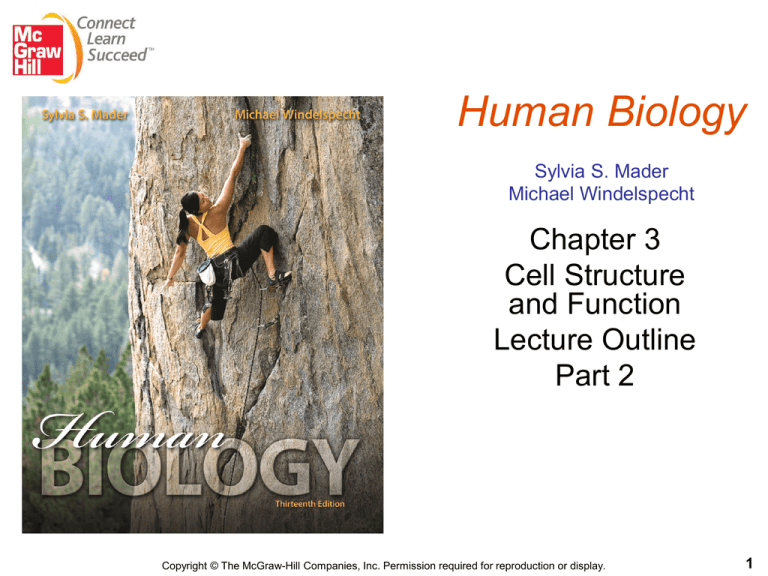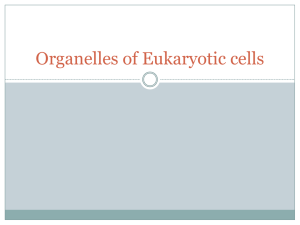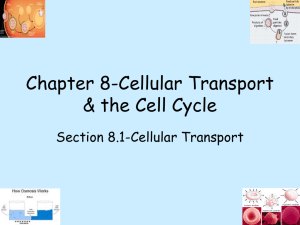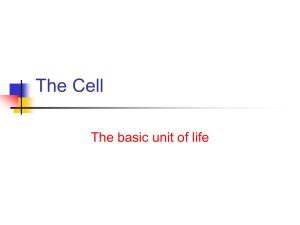Chapt03 Lecture 13ed Pt 2
advertisement

Human Biology Sylvia S. Mader Michael Windelspecht Chapter 3 Cell Structure and Function Lecture Outline Part 2 Copyright © The McGraw-Hill Companies, Inc. Permission required for reproduction or display. 1 3.2 How Cells are Organized What are the 2 major types of cells in all living organisms? • Prokaryotic cells – Thought to be the first cells to evolve – Lack a ________ – Represented by bacteria and archaea • Eukaryotic cells – Have a _________ that houses _____ – Many membrane-bound organelles 2 3.2 How Cells are Organized What do prokaryotic and eukaryotic cells have in common? • A ___________________ that surrounds and delineates the cell • A ____________: the semi-fluid substance inside the cell that contains organelles • DNA 3 3.2 How Cells are Organized What do eukaryotic cells look like? Copyright © The McGraw-Hill Companies, Inc. Permission required for reproduction or display. mitochondrion chromatin nucleolus nuclear envelope endoplasmic reticulum Plasma membrane: outer surface that regulates entrance and exit of molecules protein a. 2.5 µm phospholipid NUCLEUS: Nuclear envelope: double membrane with nuclear pores that encloses nucleus CYTOSKELETON: maintains cell shape and assists movement of cell parts: Chromatin: diffuse threads containing DNA and protein Microtubules: cylinders of protein molecules present in cytoplasm, centrioles, cilia, and flagella Nucleolus: region that produces subunits of ribosomes Intermediate filaments: protein fibers that provide support and strength ENDOPLASMIC RETICULUM: Rough ER: studded with ribosomes, processes proteins Smooth ER: lacks ribosomes, synthesizes lipid molecules Actin filaments: protein fibers that play a role in movement of cell and organelles Ribosomes: particles that carry out protein synthesis Centioles: short, cylinders of microtubules Centrosome: microtubules organizing center that contains a pair of centroles Mitochondrion: organelle that carries out cellular respiration, producing ATP molecules Lysosome: vesicle that digests macromolecules and even cell parts Figure 3.4 The structure of a typical eukaryotic cell. Polyribosome: string of ribosomes simultaneously synthesizing same protein Vesicle: membrane-bounded sac that stores and transports substances b. Cytoplasm: semifluid matrix outside nucleus that contains organelles Golgi apparatus: processes, packages, and secretes modified cell products © Dennis Kunkel/Visuals Unlimited 4 3.2 How Cells are Organized Where did eukaryotic cells come from? Copyright © The McGraw-Hill Companies, Inc. Permission required for reproduction or display. Original prokaryotic cell DNA 1. Cell gains a nucleus by the plasma membrane invaginating and surrounding the DNA with a double membrane. Nucleus allows specific functions to be assigned, freeing up cellular resources for other work. 2. Cell gains an endomembrane system by proliferation of membrane. Increased surface area allows higher rate of transport of materials within a cell. 3. Cell gains mitochondria. aerobic bacterium Ability to metabolize sugars in the presence of oxygen enables greater function and success. mitochondrion 4. Cell gains chloroplasts. Ability to produce sugars from sunlight enables greater function and success. Animal cell has mitochondria, but not chloroplasts. Figure 3.5 The evolution of eukaryotic cells. photosynthetic bacterium chloroplast Plant cell has both mitochondria cnd chloroplasts. 5 3.3 The Plasma Membrane and How Substances Cross It What are some characteristics of the plasma membrane? • • • • • It is a ____________ bilayer. It is embedded with proteins that move in space. It contains ____________ for support. It contains carbohydrates on proteins and lipids. It is _____________________. 6 3.3 The Plasma Membrane and How Substances Cross It Copyright © The McGraw-Hill Companies, Inc. Permission required for reproduction or display. plasma membrane carbohydrate chain extracellular matrix (ECM) glycoprotein glycolipid hydrophilic hydrophobic heads tails phospholipid bilayer filaments of cytoskeleton peripheral protein Outside Inside integral protein cholesterol Figure 3.6 Organization of the plasma membrane. 7 3.3 The Plasma Membrane and How Substances Cross It What does selectively permeable mean? • The membrane allows some things __ while keeping other substances ____. Copyright © The McGraw-Hill Companies, Inc. Permission required for reproduction or display. – + charged molecules and ions H2O aquaporin noncharged molecules macromolecule + – phospholipid molecule protein Figure 3.7 Selective permeability of the plasma membrane. 8 3.3 The Plasma Membrane and How Substances Cross It How do things move across the plasma membrane? 1. 2. 3. 4. 5. Diffusion Osmosis Facilitated transport Active transport Endocytosis and exocytosis 9 3.3 The Plasma Membrane and How Substances Cross It What are diffusion and osmosis? 1. ___________ is the random movement of molecules from a ________ concentration to a __________ concentration. 2. Osmosis is the __________ of water molecules. 10 3.3 The Plasma Membrane and How Substances Cross It What are diffusion and osmosis? Copyright © The McGraw-Hill Companies, Inc. Permission required for reproduction or display. particle plasma membrane water cell cell time a. Initial conditions Figure 3.8 Diffusion across the plasma membrane. b. Equilibrium conditions 11







